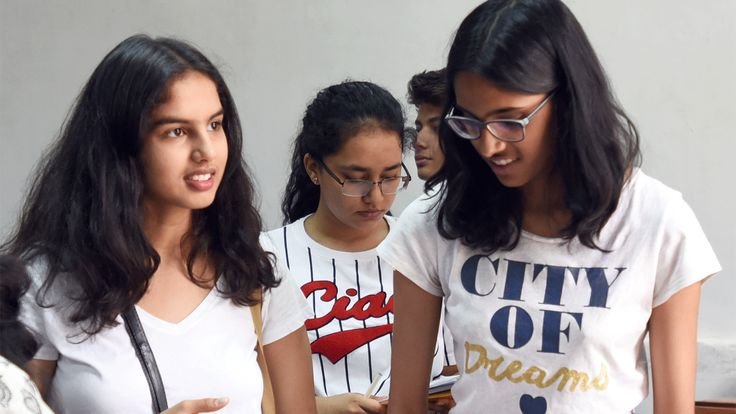A Turning Point for Aspiring Doctors
The National Eligibility cum Entrance Test Undergraduate (NEET UG) 2025 results have been declared today, marking a watershed moment in the academic lives of over 2.5 million students across India. This exam, regarded as the most challenging and competitive in the country, determines admission into medical and dental colleges nationwide. The announcement—coming amid eager anticipation—brings joy for some, heartbreak for others, and important questions for students, parents, and educators alike.
🎓 A Day of Triumph and Reflection
For lakhs of students, the release of NEET UG 2025 scores is the culmination of two years of intense study, preparation, and sacrifices. From early-morning classes to late-night revisions, aspirants recount sleepless nights punctuated by mock tests, peer discussions, and recap sessions on anatomy, chemistry, physics, and botany.
The moment the results were made public, social media exploded in a torrent of messages—tears of joy, relief, and gratitude shared by students celebrating alongside families. Teachers across the country reveled in their students’ success, proudly posting selfies and accolades from their victorious wards. Parents, a silent backbone through the pressure and uncertainty, found validation in seeing their children’s dreams take flight.
But this day also brings moments of pause. For students who couldn’t cross the cutoff, the results are a reminder of a path interrupted—of future plans to be reimagined and resiliency tested.
📊 Decoding the Results: Numbers and Cutoffs
NEET UG 2025 maintained its pattern of being fiercely competitive. The overall pass percentage hovers around 43 percent—a small surge compared to recent years but still reflective of the test’s rigor. This translates to roughly 1.08 million students achieving the minimum qualifying criteria.
Standout performers leapt several tiers above: the National Eligibility Ranks (NERs) surged ahead, with the top‐ranker scoring 701 out of 720—just two marks shy of a perfect score. Notably, the All-India Category 10 cutoff (for unreserved seats) remained high, sitting at 615 marks, ensuring that only those with outstanding performance made it through the all-India counseling rounds.
Regional variations in cutoff scores reflect broader educational trends. States like NCR Delhi, Kerala, and Maharashtra saw exceptionally stiff competition, with cutoffs ranging from 605 to 620. In contrast, northeastern and southern states had slightly more lenient benchmarks, offering better odds for regional aspirants to secure seats in state-run institutions.
📌 Who Emerges on Top?
The 800–1,000 rank band saw a rare density of nearly 15,000 students, reflecting an intensely competitive stratum where even a one-mark dip meant slipping dozens of ranks. At the very top, the top 3 rank holders—two girls and one boy—shattered records, each scoring above 700 and showcasing exceptional breadth across all four sections.
These toppers are now preparing for the All-India Counseling process, eagerly aiming for premier institutions like AIIMS, PGIMER, JIPMER, and CIP, alongside the prestigious AI IMS group of institutions.
Their success stories—a mix of self-study strategies, disciplined schedules, and peer-led revision modules—are inspiring a nation, reinforcing that excellence is both attainable and repeatable with the right approach.
📉 What About the Near-Misses?
Life after NEET UG for scores just below the cutoff unfolds in diverse ways:
- State-Level Counseling
Students scoring between 575–614 are eyeing seats in state medical colleges. Many states allocate 85–100 percent of their MBBS and BDS seats to local aspirants, offering a lifeline even with marginally lower marks. - Ayush Courses (BAMS, BHMS, BUMS)
For aspirants scoring in the mid‑500s, alternative medical degrees in Ayurveda, Homeopathy, and Unani offer viable, respected paths. These merit-based options are rapidly gaining popularity. - Allied Health Sciences
Courses like BSc Nursing, Biotechnology, Physiotherapy, and Medical Lab Technology receive robust interest from students scoring lower ranges, promising stable career opportunities. - Reattempt and Coaching
A significant number of aspirants—particularly those scoring between 450 and 575—are opting to recharge and attempt NEET UG again next year. They will likely join full-time coaching programs or online reattempt batches.
Counselors predict that nearly 40 percent of NEET UG 2025 applicants will continue in related fields, through alternate courses or reattempt strategies, reflecting a pragmatic approach to challenges and resilience in the face of setbacks.
🏫 Institutional Admissions: The Next Phase
With results out, the focus shifts to admission logistics:
- All-India Counseling (for 15 percent of seats): Begins early July. Students must register, choose streams (MBBS, BDS, AIIMS, JIPMER), and fill institution choices based on rank.
- State Counseling (85 percent of seats): Most states have historically completed seat distribution by early August. Counselling is intensifying now, with application deadlines looming.
- Central University Participation: Group counseling including institutions like Banaras Hindu University (BHU) and others will begin mid-July.
- Deemed Universities: Colleges such as Manipal, SRM, and Amrita will release merit lists and conduct admissions parallel to state UG cycles.
Payment deadlines, document verification, and seat acceptance are underway, with the first batch of classes expected to start by late August or early September.
🧠 Coaching Industry Insights
The NEET coaching industry—worth over ₹15,000 crore annually—finds itself at a turning point once results are announced. Top-performing students and unsuccessful aspirants alike make critical decisions:
- Top scorers often stop coaching and move directly into competitive university preparations.
- Reattempt aspirants evaluate new strategies, sometimes switching institutes or opting for hybrid classroom-plus-online models.
- Some coaching centers are already launching special crash-version booster batches for aspirants targeting NEET UG 2026 with above-600 target.
Social media has become a fast-moving marketplace for mentors, success stories, and exclusive strategies, with influencers and toppers sharing tips during livestreams and webinars.
📢 Student Voices: Euphoria and Resolve
- A-charya from Delhi, who scored 697, shared her excitement: “It still feels unreal. I want to pursue MBBS at AIIMS and eventually specialize in pediatrics and help underserved children.”
- Rahul from Lucknow, scoring 620, expressed gratitude for state-level success: “I didn’t make the top ranks, but the Delhi Medical College seat is well within reach. My city-focused coaching paid off.”
- Priya from Kerala, scoring 608, said she’s torn between Kerala state seats and trying for a top all-India medical school. “It’s a tough choice—home vs bigger institutes.”
- Saurav from Bihar, scoring 490, plans to join a top coaching batch and reattempt next year: “My dream is still alive. I’ll give it everything again.”
These voices reflect the spectrum of emotions ranging from ecstasy to longing, each thread part of India’s singular medical entrance tapestry.
⚖️ Equity, Diversity & Regional Gaps
NEET UG aims to create a level playing field, but disparities remain:
- Rural students underperform on average compared to urban counterparts—due largely to thinner access to quality coaching, infrastructure, and guidance.
- Girls continue to excel—they form around 55% of top 10,000-strong ranks, highlighting a sustained trend toward gender empowerment in competitive academics.
- OBC, SC/ST applicants have seen small but incremental gains due to reservation policy support, yet their average scores still trail unreserved counterparts.
- There are growing calls to increase investments in underserved areas, including digital coaching setups and regional training hubs.
Educational think tanks say that targeted interventions—such as need-based scholarships and online mentorships—could bridge these gaps over time.
🛤️ Future Pathways: Beyond NEET
For successful candidates, the next five years mark the journey to becoming doctors or dentists:
- MBBS Colleges: Curriculum includes a mix of pre-clinical, para-clinical, and clinical studies, coupled with government internship rounds and graded exit exams.
- AIIMS-PG Preparation: Students eyeing specialization can prepare early, as AIIMS entrance tests often draw from undergraduate medical standards.
- Alternative Careers: Many NEET qualifiers take interest in Bioinformatics, Medical Journalism, Public Health, or research roles, building on their strong foundational knowledge.
Meanwhile, reattempt candidates may discover alternative success in allied fields, research assistant roles, biotechnology hubs, or preparatory internships.
🗺️ Global Dimensions: Going Abroad
An emerging trend sees aspirants exploring MBBS programs overseas—in countries like Russia, China, Ukraine, the Philippines, and various Eastern European nations.
Post-result interest is flowing into international career fairs and webinars, with students looking for options abroad that promise affordable fees, English-medium instruction, and manageable culture adjustments. This global movement reveals both the demand-supply gap in MBBS seats in India and increased student mobility around the world.
🏡 Parental and Social Perspectives
For families, outcomes of NEET UG often carry emotional and financial weight:
- Many parents described a mix of pride and relief, especially after funding coaching classes and managing familial pressures.
- For unsuccessful candidates, there’s concern about the wasted year—but many are stepping in to provide emotional and financial support for reattempts.
- Social stigma around NEET results can be heavy in some communities, but attitudes are shifting gradually—with more acceptance for Ajay who chose physiotherapy over Ajay the drops-out.
Many families emphasize holistic development—leading to improved mental health, career counseling, and balanced goal-setting for the future.
🚑 Healthcare Sector Outlook
The results also hold larger significance for India’s healthcare system:
- Current doctor-to-population ratio in India is about 1:800 – 1,000, below WHO recommendation of 1:1,000. NEET UG 2025 qualifiers will gradually raise this.
- Many state governments are advocating mandatory rural or underserved area service before granting permanent registration. For rural qualifiers, first-hand exposure could shape them into future healthcare leaders.
- There is a growing emphasis on public health and preventive medicine, meaning NEET UG cohorts may significantly influence population wellness and digital health outcomes.
Medical associations are lobbying for improved job placements and infrastructure improvements across both urban and rural training hospitals.
🧭 Looking Ahead: NEET UG 2026 and Beyond
As the current cycle wraps up, attention shifts to future reforms:
- Calls are intensifying for multiple entry points in medical education, such as semester exams or internal assessments, reducing the high-stakes focus on one exam.
- Some voices suggest regional NEET UG exams to offset translation and cultural bias.
- Digital learning and AI-based test prep are being integrated into mainstream preparation strategies, aiming for equitable learning access.
- Negotiations are underway to vet admission criteria, including curriculum-weighted assessment along with NEET score—and evolving career counseling into a structured tool.
These discussions may shape education policy changes as soon as the next academic year.
📝 Summary Table
| Aspect | Highlights |
|---|---|
| Year of Exam | 2025 |
| Registrants | ~2.5 million |
| Qualifiers (%) | ~43% (1.08 million) |
| Top Score | 701 / 720 |
| All-India Unreserved Cutoff | 615 |
| State-Level Cutoffs | 605–620 in high-competition states; 580–600 in others |
| Alternate Courses | BAMS, BHMS, Nursing, Allied Health, Reattempts |
| Gender Performance | Females ~55% of top 10,000 |
| Rural vs Urban Disparity | Urban consistently outperforming |
| Key Issues | Coaching, access, diversity, exam reform |
✨ Final Thoughts
The declaration of NEET UG 2025 results heralds a new chapter for India’s young medical aspirants. It’s a moment overflowing with dreams realized, aspirations redefined, and systemic reflections. Some have soared to the top, others face detours—but all are participants in a vast movement shaping India’s healthcare future.
In the years ahead, these students will become nearly every kind of health professional imaginable—in MBBS, dentistry, AYUSH, critical care, research labs, or innovation centers. They will carry not just test scores, but the hopes and hard work of families, educators, and a nation striving for healthier tomorrows.
As the next academic sessions begin, the spotlight will shift from results to resilience, from numbers to narratives. Whatever path students take—through hospital wards, classrooms, labs, or global seminars—the foundation laid today will influence their journey profoundly.
Congratulations to the NETT UG 2025 qualifiers. To those rebuilding paths: your potential is undiminished. And to all watching, may today’s outcomes contribute to brighter healthcare for India and beyond.


